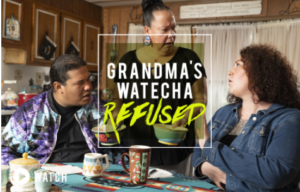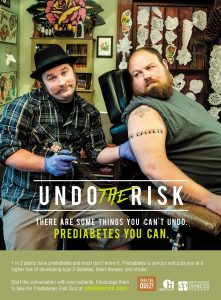
From a tattoo gone wrong to refusing grandma’s watecha, the South Dakota Department of Health’s Undo the Risk video collection uses diverse and humorous scenarios to relay the message that diabetes can be prevented. Awkward “undoable” situations portrayed include a cringe-worthy first date, regrettable reply all, and school project secrets. The campaign features a Native American family and includes a Spanish language option.
uses diverse and humorous scenarios to relay the message that diabetes can be prevented. Awkward “undoable” situations portrayed include a cringe-worthy first date, regrettable reply all, and school project secrets. The campaign features a Native American family and includes a Spanish language option.
Health care and community organizations are encouraged to use the videos, promote the Undo the Risk quiz, and take advantage of the provider resources during Diabetes Alert Day on March 22, 2022, and beyond.
Following up with risk tests and referring individuals to enroll in a National Diabetes Prevention Program (NDPP) or evidence-based chronic disease self-management option in North Dakota or South Dakota may prevent diabetes and improve quality of life. In addition, Live Your Best  enables all South Dakota providers to deliver the NDPP content using an online platform and mobile applications.
enables all South Dakota providers to deliver the NDPP content using an online platform and mobile applications.
For more information on diabetes prevention and control in South Dakota, contact Kayla Magee, RN, diabetes program coordinator, at (605) 773-2981
 My Diabetes Prevention Program (DPP) Experience
My Diabetes Prevention Program (DPP) Experience
Excerpts from the testimonial of Rod Mulske
My family has a history of diabetes, with my maternal grandmother, my mother, and several aunts and uncles all having to use insulin injections to control it. Even with their medications, they all suffered adverse effects from diabetes that caused them medical issues.
During my annual physical in November of 2020, my doctor informed me that my test results showed that I was considered pre-diabetes. She recommended that I enter into a diabetes prevention program. I agreed, because, as I stated before, I watched family suffer from the effects of diabetes, and I didn’t want to get to that point.
My DPP coach, Emily Lauinger, called me and helped me to enroll in the program. On our first session in January 2021, Emily stated that losing seven percent of body weight will move a person out of pre-diabetes status. That piqued my interest, and set my goal to losing that seven percent.
After six months of my DPP classes, I had surpassed my goal of seven percent [weight loss] and am proud to say I lost 15 percent of my body weight. Not only did I lose [weight], my November 2021 annual physical showed that I am no longer in the pre-diabetes stage.
During one of our early sessions, Emily introduced us to My Fitness Pal (MFP). Using the tracking, along with changing my eating habits, I was able to lose the weight to reach my goal. Working with my DPP team and Emily, I learned better eating habits and found more different foods to fit into a healthy eating program. The weekly, then bi-weekly, then monthly DPP team meetings became very informative and were a great opportunity to interact with a group with the same goals. Even though we had different reasons for wanting to lose weight, we all shared a common, genuine interest in helping each other to reach their individual goals.
My number one encouraging team was my family. They never pushed me to work my goals, but they supported my endeavors by creating menus that would fit into my daily goals and accepting my tracking every meal on MFP. Even my grandchildren would ask, “Papa, can you eat this food?”
Long story short, DPP and my support groups helped me to overcome the initial challenge of beginning a weight loss program and to reach my goals. As of the writing of this article, I have logged 383 consecutive days of tracking in MFP and plan to continue for life to help me maintain my goal.
Additional Educational Opportunities
National DPP classes are offered in-person, online, and through distance learning options. Healthcare professionals are encouraged to refer individuals at risk for developing diabetes to enroll in a program.
- North Dakota: http://www.NDC3.org
- South Dakota: https://www.undotherisk.com/find-a-program
Source: Great Plains QIN Q Insider March 2022
